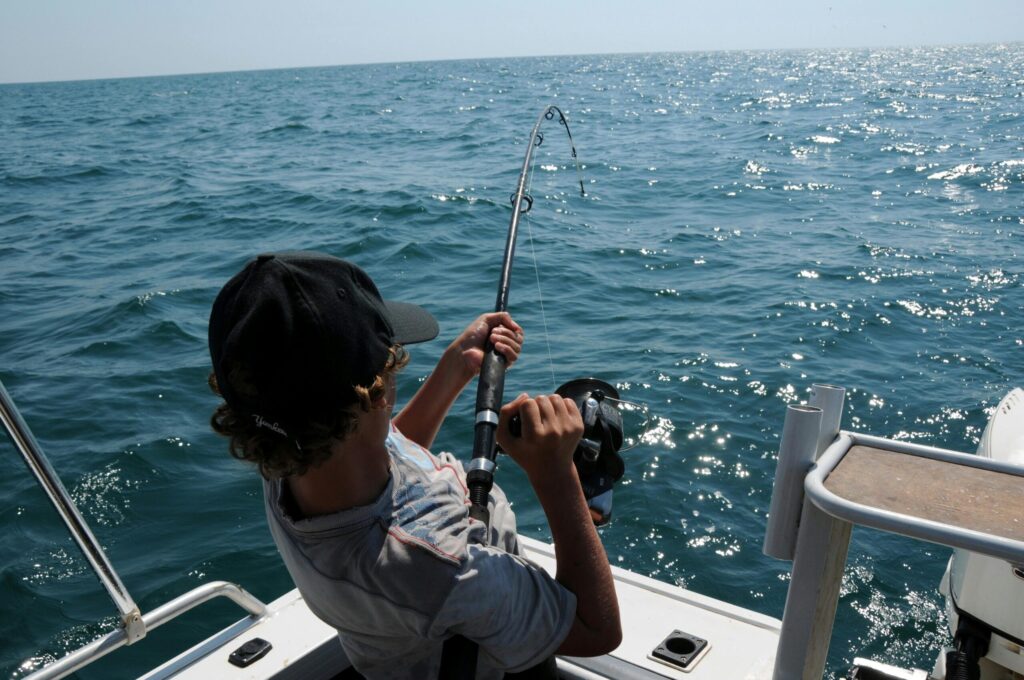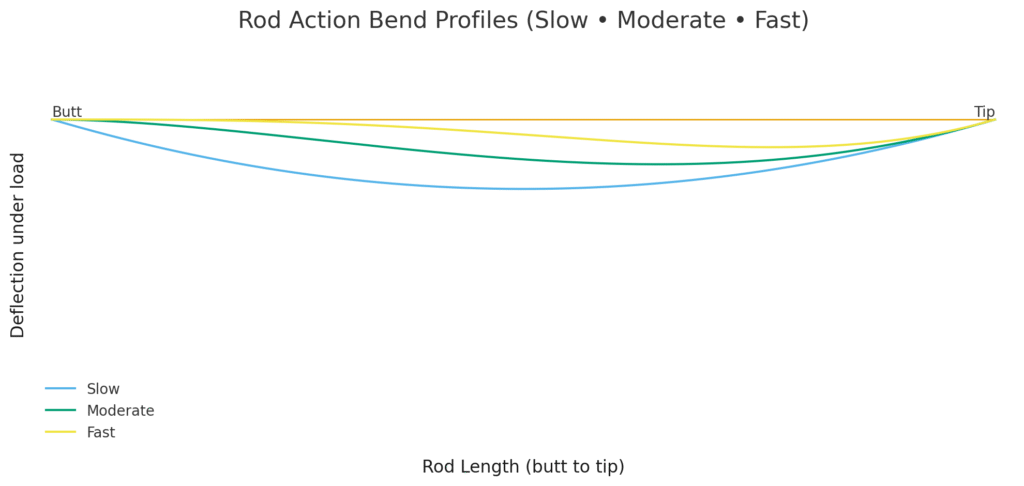
If rod power vs action still feels like alphabet soup, you are not alone. I have been on the water for many years, and I can tell you this: when your rod’s power and action match the fish, the cover, and the bait, everything clicks. Casting gets easier, hooksets land cleaner, and fish come to the net with less drama. If you are still picking a reel style, start with this guide on Spinning vs Baitcasting Reels, Real-World Differences.
TL,DR: Rod power is backbone, Ultralight to Extra-Heavy, match it to fish size and cover. Rod action is where the blank bends, Slow to Extra-Fast, match it to the presentation, trebles like Moderate, single hooks like Fast to Extra-Fast. From a kayak, a 6’6” to 7’3” Medium, Fast covers most days, add Medium-Heavy, Fast for grass, and Medium, Moderate for cranks.
Contents
Rod Power and Rod Action, Plain and Simple
Rod power is the rod’s resistance to bending, the backbone. You will see labels such as Ultralight, Light, Medium-Light, Medium, Medium-Heavy, Heavy, and Extra-Heavy. Power lines up with the printed line and lure ranges on the blank, so read those numbers, they matter.
Rod action is where the rod bends and how fast it recovers. Actions are Slow, Moderate, Moderate-Fast, Fast, Extra-Fast. Action drives casting feel, bite detection, hooksets, and how well treble hooks stay pinned when a fish surges boatside.
Quick home test: hang a small weight from the tip. If mostly the tip bends, that is Fast to Extra-Fast. If the bend reaches about halfway, that is Moderate. If it bends deep toward the butt, that is Slow. Simple, effective, and it tells you a lot.
A Quick 3-Step Selector
- Target and cover decide power. Heavy fish or thick cover, step up in power. Small fish or open water, step down.
- Presentation decides action. Single hooks and bottom contact like Fast to Extra-Fast. Treble-hook baits like Moderate to Moderate-Fast.
- Check the numbers. Stay inside the printed line and lure ranges on your rod; you will cast better and break less gear.
If you fish from a kayak, leverage is limited. A touch more backbone or a tick faster action helps move fish quickly when they are green at the net. For boat handling fundamentals, see Kayak Fishing Tips.
Cheat Sheet, Species, And Techniques
| Target or Technique | Typical Power | Typical Action | Why it Works |
|---|---|---|---|
| Trout in small streams | Ultralight to Light | Moderate to Moderate-Fast | Protects light line, casts tiny lures, keeps fish pinned |
| Finesse bass, ned or drop shot | Medium-Light | Fast to Extra-Fast | Sensitive tip with enough backbone for light wire hooks |
| All-around bass, bank or kayak | Medium | Fast | Versatile for Texas rigs, spinnerbaits, small jigs |
| Jigs, Texas rigs in moderate cover | Medium-Heavy | Fast | Better hook penetration and control |
| Frogs, punching, heavy grass | Heavy | Fast to Extra-Fast | Moves fish out of slop, turns heads quickly |
| Crankbaits, treble-hook moving baits | Medium to Medium-Heavy | Moderate to Moderate-Fast | Deeper bend absorbs surges and keeps trebles buttoned |
| Surf casting heavy payloads | Medium-Heavy to Extra-Heavy | Moderate-Fast | Loads deeper for distance and control in current |
| Inshore reds, snook | Medium to Medium-Heavy | Fast | Long casts with accuracy around structure |
Want to sharpen your boat-side game and land more fish you already hooked, read Tips To Become a Better Kayak Angler. Those small adjustments pay off fast.
Power Scale With Common Line And Lure Windows
These are typical ranges, brands vary, so always check your rod’s printed specs before tying on something heavy.
| Power | Mono or Fluoro | Braid | Lure Weight |
|---|---|---|---|
| Ultralight | 2 to 6 lb | 4 to 8 lb | 1/64 to 1/8 oz |
| Light | 4 to 8 lb | 6 to 10 lb | 1/16 to 1/4 oz |
| Medium-Light | 6 to 10 lb | 8 to 15 lb | 1/8 to 3/8 oz |
| Medium | 8 to 14 lb | 10 to 20 lb | 1/4 to 3/4 oz |
| Medium-Heavy | 10 to 17 lb | 15 to 30 lb | 3/8 to 1 oz |
| Heavy | 12 to 25 lb | 30 to 65 lb | 1/2 to 2 oz |
| Extra-Heavy | 15 to 30+ lb | 50 to 80+ lb | 1 to 4+ oz |
Action, translated into feel

- Extra-Fast: the top 15 to 20 percent bends, snappy hooksets, great for single hooks and bottom contact.
- Fast: roughly the top quarter bends, versatile for a lot of bass work.
- Moderate-Fast: the upper third bends, a great middle ground for chatterbaits and spinnerbaits.
- Moderate: the bend reaches the midpoint, forgiving with trebles on cranks and jerks.
- Slow: deep, parabolic bend, best when you want pure shock absorption.
Power and action together, proven pairings
- UL, Moderate, panfish and tiny trout lures.
- ML, Fast, finesse bass and light jigs.
- M, Fast, the do-it-all starter rod.
- MH, Fast, jigs, worms, spinnerbaits in light to medium cover.
- MH, Moderate-Fast, bladed jigs and other moving baits.
- H, Fast or X-Fast, frogs and punching.
If you like digging into diagrams and terminology, Shimano’s quick breakdown is solid and easy to follow.
Casting, Hooksets, And Landing
Fast and Extra-Fast actions load quickly and drive hooks with less travel, which is money for single-hook techniques and bottom contact. Moderate actions load deeper, smooth out headshakes, and help you keep trebles pinned on crankbaits and jerkbaits, especially when a fish makes a late surge near the boat.
The Kayak Angle
Fishing while seated changes your leverage and landing angles. In tight quarters, a 6’6” to 7’3” rod manages cleanly around a PFD and a net. If you hike or travel with your rods, compact multi-piece setups are worth a look. Compare options in Travel and Telescopic Rods.
Buying Checklist
- Pick target species and cover, match power accordingly.
- Pick a presentation, match the action accordingly.
- Stay inside your rod’s printed line and lure ranges.
- Treble heavy baits, lean Moderate. Single hooks and bottom contact, lean Fast to Extra-Fast.
- From a kayak, favor manageable length and a handle that clears your PFD.
Quick Recommendations By Scenario
- One rod starter: Medium, Fast, right around 7 feet, spinning or casting. On a budget, check Best Spinning Rods Under $100, and pick the build that fits your water.
- Add a jig or frog setup: Medium-Heavy to Heavy, Fast.
- Dedicated cranking setup: Medium, Moderate, or a composite blank if you like a little snap on the cast.
- Finesse spinning: Medium-Light, Fast, 6’10” to 7’2”.
Make Your Pick
Dial it in and fish. Start with a do-it-all Medium, Fast for bank and kayak work, add a Medium-Heavy, Fast for jigs or frogs, then a Medium, Moderate for cranks. Compare a couple of models, make sure your line and lure choices land inside the printed ranges, then go test it on the water. You will feel the difference.
Some links on OutdoorCraving may earn us a small commission if you buy through them, at no extra cost to you. That support helps us keep publishing free guides.
FAQs
Is power the same as stiffness?
Not exactly. Power is how much load it takes to bend the blank; stiffness is the feel you experience from that resistance.
Can two Medium power rods feel different?
Yes. Action, taper, and materials change casting, sensitivity, and recovery, so two Mediums can perform very differently.
Fast versus Moderate for crankbaits?
Moderate wins most of the time because the deeper bend keeps trebles pinned during surges.
Why do brands list different ranges for the same rating?
There is no strict universal standard across all manufacturers. Always trust the specific rod’s printed line and lure ranges.
